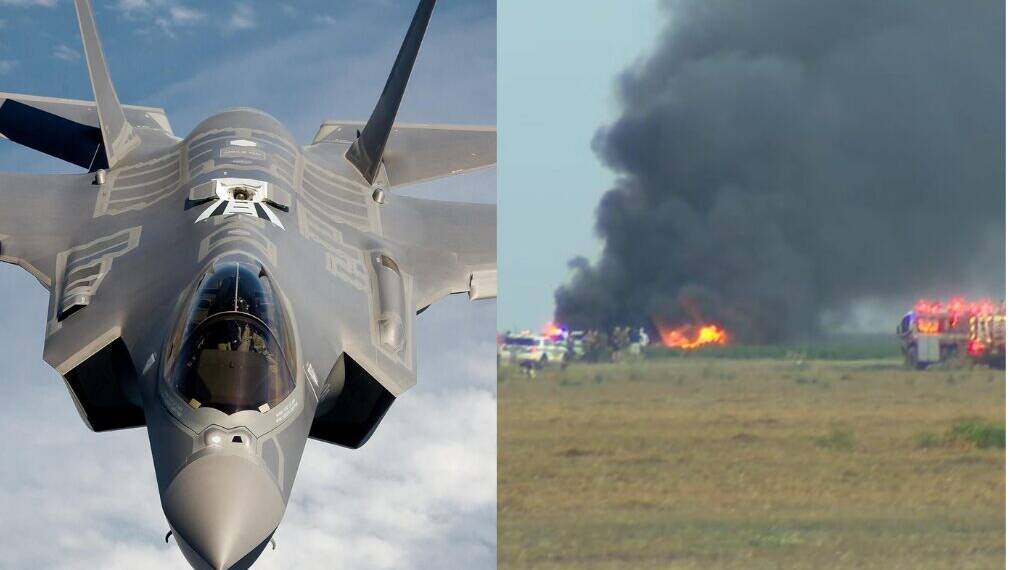The F-35 Lightning II, once heralded as the crown jewel of modern aerial warfare, is facing renewed scrutiny following two high-profile incidents in July 2025: the crash of a US Navy F-35C near Naval Air Station Lemoore in California, and the prolonged grounding of a British F-35B in Kerala, India.
These events have once again sparked a global debate over the reliability and sustainability of the world’s most expensive military aircraft program.
A Crash That Raises Old Questions
On July 30, 2025, a US Navy F-35C fighter jet from Strike Fighter Squadron VFA-125 crashed near NAS Lemoore. The pilot ejected safely, but the aircraft—a key asset for carrier-based naval operations—was completely lost. Footage shared by ABC10 and posted by the Global Times on social media shows billowing black smoke and emergency responders tackling a fierce blaze. While the cause is still under investigation, the incident marks the second F-35 crash in 2025 alone.
This crash adds to a long list of mishaps involving the F-35, including issues ranging from in-flight fires and hard landings to complex software bugs. According to publicly available accident records, the F-35 has suffered more than two dozen serious incidents since it began entering service in 2015. Despite years of development and an astronomical total program cost now exceeding $1.7 trillion, reliability remains a recurring concern.
Grounded in Kerala: A Jet That Couldn’t Leave
Compounding these concerns is a separate incident involving a British F-35B that was stranded for nearly a month at Thiruvananthapuram International Airport in Kerala, India. The aircraft, part of a deployment from the HMS Queen Elizabeth, suffered a fuel tank issue on June 14, 2025, and remained grounded until mid-July.
Despite the combined efforts of British engineers and Indian support personnel, repairs took far longer than expected—prompting international headlines, viral memes, and questions about the F-35’s deployability in unfamiliar environments.
The so-called “lonely F-35B” became an internet phenomenon, but beneath the humor lies a sobering truth: even minor technical issues can incapacitate the jet for extended periods, particularly when spare parts, specialized tools, or trained technicians are unavailable.
Public and Expert Criticism Mounts
Social media platforms, especially X lit up with reactions ranging from sarcasm to concern. Comparisons to the notoriously crash-prone MiG-21 surfaced frequently, with users dubbing the F-35 a “flying coffin.” While some of these comments are hyperbolic or politically charged, they reflect a genuine and growing skepticism about the F-35’s reliability.
Defense analysts are also increasingly vocal. “The F-35 is brilliant on paper but fragile in practice,” one military aviation consultant noted. “It’s a jet that promises to do everything—stealth, speed, dogfighting, electronic warfare—but ends up in the news for all the wrong reasons far too often.”
Operational Readiness vs. Reality
The F-35C, designed specifically for carrier operations, is a cornerstone of the US Navy’s air strategy. Its crash at Lemoore raises immediate operational concerns: How will training schedules adjust? Will this delay deployments? Can the Navy afford to keep losing $100+ million aircraft during peacetime training missions?
Meanwhile, the long repair time for the F-35B in Kerala throws into sharp relief the logistical burdens of deploying these aircraft globally. In contested or remote regions, even minor technical failures could render the aircraft inoperable, potentially compromising missions.
A Strategic Asset Under a Cloud
The F-35 program was developed to ensure US and allied air dominance through 2070, integrating stealth, supersonic performance, and state-of-the-art sensors. However, the program’s chronic delays, software bugs, cost overruns, and now a worrying pattern of mechanical and operational failures raise the question: is the F-35 truly fit for the demands of modern warfare?
Nations such as India, which have shown interest in acquiring or collaborating on fifth-generation fighter platforms, now face a strategic dilemma. Do they invest in the F-35—with its superior tech but mounting baggage—or look elsewhere, such as Russia’s Su-57 or indigenous alternatives?
Geopolitical Repercussions
The recent incidents are not just technical failures; they are geopolitical signals. Chinese state media, including the Global Times, have seized on the Lemoore crash to highlight perceived flaws in US defense technology. This messaging is part of a broader narrative aimed at undermining American military credibility while promoting domestic alternatives like China’s J-20 stealth fighter.
The Kerala incident, meanwhile, played out in a strategically neutral country that is currently navigating defense partnerships with both the West and Russia. The optics of a top-tier NATO aircraft sitting idle in India for weeks do little to bolster Western technological prestige.
A Program at a Crossroads
The F-35 remains an unparalleled technological achievement in many respects. But cutting-edge innovation must be matched by real-world dependability. As the Lemoore crash and Kerala stranding demonstrate, the F-35’s Achilles’ heel may be its inconsistency under operational stress—especially when deployed away from home turf.
For the United States and its allies, the F-35’s future hinges on whether these problems are growing pains or symptoms of deeper flaws. Without credible improvements in reliability and support infrastructure, the program risks becoming a symbol not of superiority, but of overreach.
The F-35 may still dominate airshows and military brochures. But on the ground—and in the headlines—it’s increasingly under fire.








